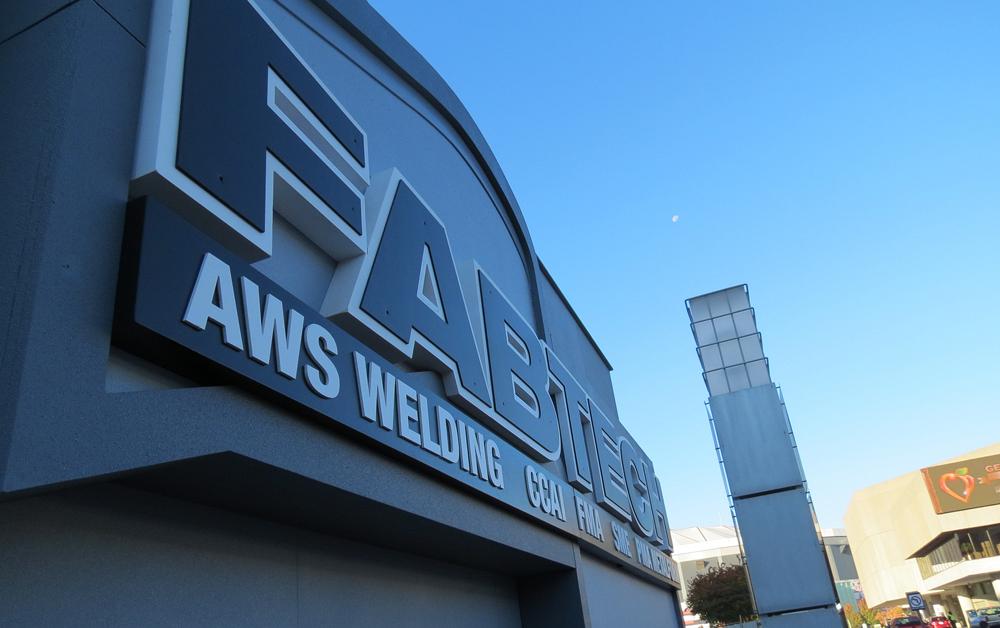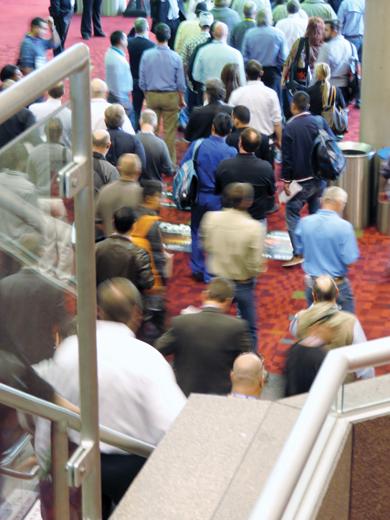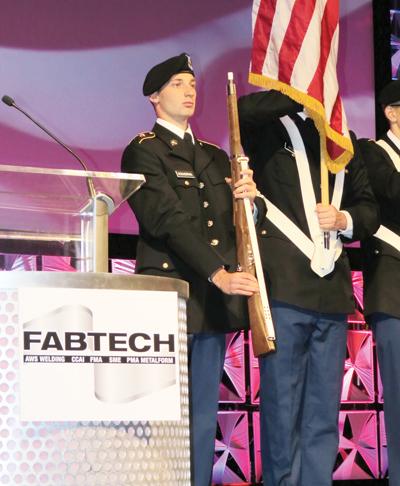Senior Editor
- FMA
- The Fabricator
- FABTECH
- Canadian Metalworking
Categories
- Additive Manufacturing
- Aluminum Welding
- Arc Welding
- Assembly and Joining
- Automation and Robotics
- Bending and Forming
- Consumables
- Cutting and Weld Prep
- Electric Vehicles
- En Español
- Finishing
- Hydroforming
- Laser Cutting
- Laser Welding
- Machining
- Manufacturing Software
- Materials Handling
- Metals/Materials
- Oxyfuel Cutting
- Plasma Cutting
- Power Tools
- Punching and Other Holemaking
- Roll Forming
- Safety
- Sawing
- Shearing
- Shop Management
- Testing and Measuring
- Tube and Pipe Fabrication
- Tube and Pipe Production
- Waterjet Cutting
Industry Directory
Webcasts
Podcasts
FAB 40
Advertise
Subscribe
Account Login
Search
Flying high at FABTECH
Optimism pervades Atlanta show, with a dose of pragmitism
- By Tim Heston
- January 8, 2015
- Article
- Shop Management
Four years ago Chris Scripsick stood at the FABTECH® show floor entrance in Atlanta. Although the sales engineer’s employer, Humboldt, Kan.-based B&W Trailer Hitches, a product line and contract fabricator, was just emerging from the worst economic downturn anybody could remember, Scripsick still had a good story to tell. Instead of laying anybody off, the company sent people back into the community. Machine operators and welders repaired ball fields, refurbished parks, even did small jobs at each other’s homes. By 2010 the company had made it through, kept its core talent, and was ready to grow.
In 2014 Scripsick was back at FABTECH, and he had an even better story to tell. “Since 2009 we’ve doubled our employment and doubled our sales. We’ve just added another 100,000 square feet. We’ve purchased four lasers over the past year, and six robotic welding cells. Business is really, really good.”
What a difference four years makes. This year’s Atlanta show had more than a half-million sq. ft. of exhibit space that spanned all three halls at the Georgia World Congress Center. Organized by five partner organizations—the Fabricators & Manufacturers Association International® (FMA), American Welding Society (AWS), Precision Metalforming Association (PMA), SME, and the Chemical Coaters Association International (CCAI)—the Nov. 11-13 event drew more than 30,200 people to visit nearly 1,500 exhibitors (see Figure 1).
Several themes dominated the exposition. First, as always, many talked about trouble finding skilled labor, but this year more talked about practical ways to match the right technically apt person with the right job. There was less “we can’t find good people” and more “here’s what we’re doing to find the right person.”
Second, manufacturing technology is becoming not only faster and more powerful, but more intuitive and communicative, often in futuristic ways. As just one example, augmented reality technologies are emerging as a serious manufacturing tool.
Third, the metal fabrication arena isn’t just growing, it’s gotten a lot better at supply chain collaboration and mitigating risk. This includes revenue concentration in custom fabrication. OEM representatives in one industry panel said they, of course, focus on price, delivery, quality, new manufacturing ideas, and innovation—all the familiar buzzwords—but they also value a custom fabricator’s revenue diversity.
OEM reps at the show said they have built closer relationships with their preferred metal fabrication supply bases since the Great Recession. But they know all too well that business is a cyclical beast, and they certainly don’t want to be any custom fabricator’s sole source for survival.
Building Talent
Steps away from the American Welding Society U.S. Invitational Weld Trials for the WorldSkills competition, attendee Ryan Blythe looked on. The executive director at Georgia Trade School in nearby Kennesaw has seen local demand skyrocket, especially in the construction equipment and transportation sectors. Space in the school, he said, is sold out through April.
“TrinityRail came back to the Atlanta area after shuttering its railcar manufacturing facility in 2009,” he said. “Now, with the increased demand for railcars, particularly for transporting oil, the company has reopened its facility, and it needs to hire several hundred welders. They have increased starting pay from the $12- to $14-an-hour range five years ago to $17 to $20 today.”
During an economic forecast breakfast at the show, Chris Kuehl, FMA’s economic analyst, cited one statistic from the Federal Reserve stating that for every person looking for work there are two available job openings. The problem, of course, is that many jobs still go unfilled because companies can’t find the people with the needed skills. That’s become an old story in this business.
Kuehl, who’s also managing director of Armada Corporate Intelligence, Lawrence, Kan., summed it up this way: “The United States has 758 schools that offer advanced degrees in film studies. It has 26 schools that offer advanced degrees in industrial management.”
Unemployment has fallen below 6 percent, and it’s heading downward. Of course, many have criticized the most-cited unemployment figure, technically dubbed the U3, which doesn’t count people as unemployed unless they are actively looking for work. The U6, which includes people who could work but have stopped looking, is about double the U3. However, Kuehl then showed a slide that revealed a telling trend, one that puts the unemployment numbers in a broader context: For the past few decades, the U6 has always been about double the U3, even during the 1990s when unemployment hit record lows.
Regardless, he said, the unemployment rate is an imperfect measurement. People are indeed getting back to work, though many aren’t working as much as they would like, and many aren’t choosing manufacturing. Attendee Michael Colonnese cited one big reason: Schools and industry aren’t aligned. It’s not just a matter of degrees in film criticism versus industrial management (though that’s significant); it’s also because many existing trade schools aren’t on the same page as industry. To get everyone on the same page, Colonnese launched Washington, D.C.-based Work America.
The organization, he said, helps technical schools develop curriculum to match what local employers really need. It’s basically a recruitment service, but with a twist: “We tell employers that we’re going to work with the schools to fix their curricula, to make it up to par,” Colonnese said. “In turn, the employers need to provide a guarantee that they will hire the students once they graduate.”
The show hosted various organizations aiming to narrow the skills gap, including several veterans groups (appropriate, considering the show’s Nov. 11 opening date) with the mission to link veterans with the skilled trades. Presenting at an Amada press event, Hernán Luis y Prado, president of San Diego-based Workshops for Warriors, said the organization has had a 100 percent placement rate, with 140 graduates, 49 currently enrolled, and more than 500 on the waiting list.
During the opening keynote, members of Georgia Tech’s ROTC presented the colors for the national anthem, sung by a tenor from the Atlanta Opera, after which Cindi Marsiglio, vice president of U.S. manufacturing at Walmart, walked onto the stage (see Figures 2 and 3). The retailing giant recently pledged to spend $250 billion over the next decade on products made or assembled in the U.S. Marsiglio referred to it as a “$250 billion purchase order,” which the company announced a year ago at the National Retail Federation’s annual conference in New York.
“Everything is on the table,” she said, including appliances, kitchenware, and, well, tables—specifically lawn furniture. The retailer has been working with companies to manufacture metal patio furniture stateside. Such furniture, she explained, represents the company’s new thinking about true supply chain costs, especially when it comes to seasonal items.
Walmart has been working with the Boston Consulting Group, the same organization that has predicted a manufacturing renaissance, to determine where to reshore products. For seasonal items in particular, a shorter supply chain makes business sense. “We’re challenging our merchants to rethink their buying and purchasing strategies,” she said. “It was a nice summer, and I would have liked to have more patio furniture to sell.”
The company is taking a methodological approach, she said, explaining that quite often assembly is a first step in developing a full-blown, U.S.-based manufacturing supply chain. She referred to Kent International, a bicycle company that’s now assembling products in South Carolina.
Marsiglio added, however, that bringing products stateside of course has to make business sense for customers and company shareholders. “We would like nothing more than to sell gas grills made in the U.S.,” she said, before pausing a bit and adding a telling coda—“sold at the right price point, of course.”
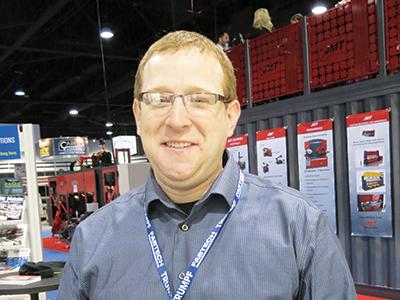
“One of the things that we learned [after the recession] is to diversify out of the construction industry.
All of our customers support us
in that effort. A lot of them will
give us recommendations and
even testimonials, because they know that it will make us a better supplier.”
—Eric D. Miller, Miller Welding & Machine Co., Brookville, Pa.
Building Financial Health
“Do you have a solution for me?” So asked David Whelan, senior vice president of supply chain for school bus OEM Blue Bird during “State of the Industry, an Executive Outlook,” a keynote panel held the second day of the show.
The panel also included Todd Henry, an operations manager at Caterpillar who is managing the OEM’s new plant outside Athens, Ga.; and Jody Fledderman, chairman of PMA and president of Batesville Tool & Die, an automotive stamper based in Indiana and Mexico. Moderating the panel was FMA Chairman Edwin Stanley, vice president of sales and finance at Fort Payne, Ala.-based GH Metal Solutions.
At its new Athens facility, Caterpillar is manufacturing a product previously produced in Japan. About 75 percent of the components that were sourced in Japan are now sourced stateside, mostly in the Southeast. It has hired about 650 employees during the past year and a half, including about 175 welders. “We’ve got a total of 850 employees now, and we’re ramping up to 1,400 over the next two years.
“There’s an opportunity to collaborate, to make sure we’re both successful in a partnership,” Henry said. “And the last piece is management. Do you have lean manufacturing or related improvements implemented in your facility? Do you have robust process control? Are you managing the business effectively so that you’re healthy financially? All that is the minimum baseline requirement to get your foot in the door.”
Financial health of suppliers was a common theme. Since the downturn some OEMs have made moves to reduce the number of suppliers they work with to reduce costs and simplify their purchasing functions. The last thing an OEM wants in this situation is for a supplier to fail.
“When we work with a new supplier, we want to know what the makeup of their business is,” Whelan said. “We’re looking for suppliers with offsetting cyclical business. If three-quarters of their business occurs during my slow time, that’s a perfect supplier for me, because I’m going to take up his capacity [during the fabricator’s slower times].”
Fledderman said his company tries to choose products that wouldn’t be easy for the OEM to bring in-house during slow times. “We’re careful about what our customer’s abilities are,” he said. “We don’t want them to mirror what we do. We want to bring something to the table that they don’t have.”
Henry described how diversification has become important. “If we go after all suppliers who serve nothing but the construction market, then we’re going to be in trouble. When we’re up, they’re up, and when we’re down, they’re down. Having that diversity in the customer base is key.”
To that end, many fabricators continue to communicate with customers, including show attendee Eric D. Miller, vice president of sales and marketing for Brookville, Pa.-based Miller Welding & Machine Co. “Our sales dropped about 80 percent between 2009 and 2010. One of the things that we learned is that we need to diversify out of the construction equipment industry. We’re not trying to subtract business, but at the same time, we have to be very careful not to overcommit. And all of our customers support us in this effort. A lot of them will give recommendations and even testimonials. Ultimately, they know it will make us a better supplier.”
Building Capacity
With customers demanding quick turnaround and last-minute changes, flexibility remains as important as ever. The collection of equipment at FABTECH this year aimed to meet this demand.

“Our plan for the next five years is 10 percent year-over-year growth. Since 2010 we’ve had a 15 percent compounded annual growth rate. We’re at a good place right now. We’re adding new powder coat lines, new technology, and have plans
to add a new plant. We need to
continue to reinvent ourselves.”
—Jared Lotzer, BTD, Detroit Lakes, Minn.
The latest in fabrication equipment aims to reduce manufacturing time by shortening processing time and eliminating secondary operations. For instance, a punch press introduced by LVD (www.lvdgroup.com) touts the ability to bend flanges nearly 3 inches high (see Figure 4). It can emboss, tap, as well as (of course) punch.
Fiber and disk lasers continue to make their push into thicker material. Machine tool manufacturers are offering higher powers—an 8-kW disk laser from TRUMPF (www.us.trumpf.com) and a 12-kW fiber laser from MegaFab (www.megafab.com)—as well as systems, such as one from Amada (www.amada.com), with proprietary techniques that allow a 2-kW fiber laser to slice through both thin and thick material, without the need for a lens change. TRUMPF also showed the potential of beam switching, demonstrating a setup in which a disk laser power source was shared between a laser cutting machine and robotic welding cell (see Figure 5).
The focus on throughput extended to bending, where exhibitors showed electric machines offering faster bending cycles. One robotic system on display from Amada churned through various small parts, changing tools automatically (see Figure 6). On some machines the operator performs the bending while automation performs the tool change. Several systems on the floor, including one from Amada and another from LVD, touted mechanized systems that could swap out punches and dies.
In welding, more exhibitors touted offline robot programming and simulation, including several third-party vendors, such as Octopuz (www.octopuz.com), which the company says can work across multiple robotic welding platforms. One software provider, Robotmaster (www.robotmaster.com), offered a “click-and-drag” simulation system that can detect collisions, as well as joint and reach limits, via a graphical interface (see Figure 7).
Besides increased throughput, another theme pervaded this year’s show: having the right information at the right time. For instance, Bystronic (www.bys tronic.com) exhibited its OPC interface, an open communication standard that connects sensors in its machines to front-office software, along with web browser-based process monitoring software that shows the status of machines and jobs on the floor. The company also showed a nesting engine that uses large-scale computing power in the cloud (see Figure 8).
Information doesn’t come just from computer screens anymore, either. Several companies showcased augmented-reality technology in which—in Google Glass fashion—information is overlaid on real-world elements. In fact, several Google representatives made it to the show, and they brought Google Glass with them. Mike Walton, head of manufacturing at Google, presented FABTECH’s final keynote, showing (among other things) augmented reality’s potential on the factory floor. Several manufacturers, including Boeing, are using Google Glass in assembly operations.
Los Angeles-based DAQRI (www.daqri.com) showed its own augmented-reality platform (see Figure 9). Anyone wearing the company’s Smart Helmet can see an actual 3-D CAD image, complete with visual work instructions, over the real object at hand, be it for maintenance and repair or quality checks for manufacturing.
“The system can recognize objects around you, and with its inertial measurement unit, it knows exactly where you are within space and time,” said Ken Hepburn, DAQRI’s director of business development. “If you’re in a plant, it will triangulate off of a Wi-Fi signal to be able to figure out the exact position, so it knows where you are relative to the assembly. You can also do part inspection right at the machine. You can take a part off of a machine, look at it, and be able to authorize as to whether or not the part is to the correct tolerances. It can also take a picture of it and send it back to your ERP system.”
Tailoring its product for technical schools, Realityworks (www.realityworks.com) displayed an augmented-reality welding system. As the student performs an actual weld (not a computer simulation), the system detects the gun angle, work angle, travel speed, and then, in the periphery of the helmet lens, shows the student how he or she should adjust for a proper weld (see Figure 10).
Building Success
Jared Lotzer has good reason to smile. The vice president of sales for BTD, a $167 million contract fabricator in Detroit Lakes, Minn., said the company could have had a challenging year, considering its business in the agricultural equipment sector, which has seen better days.
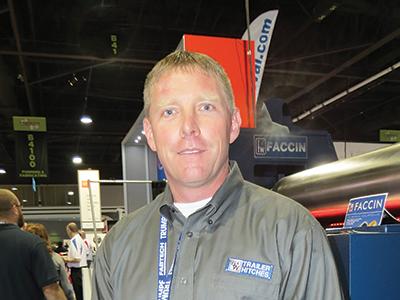
“We just added another 100,000 square feet, four lasers, and six
robot welders. Back in 2008 and 2009, when everything was tough, we put people to work in the
community—on ball fields,
churches, and other community projects. We retained our full
workforce. Now we have 350
employees. That’s up from 180
in 2009.”
—Chris Scripsick, B&W Trailer Hitches, Humboldt, Kan.
Despite all this, 2014 wasn’t bad at all for BTD. It’s adding another 180,000 sq. ft. of manufacturing space as part of a $33 million expansion. It’s hoping to open a new plant in the Southeast by 2017 to service customers in the lawn and garden and recreational vehicle markets. In fact, recreational vehicles is one area that has kept BTD’s floor busy during the past year, along with the oil and energy markets.
“Agriculture is down, but our rec business is really good now,” Lotzer said, “and so is our work for the energy market. We make a lot of components for hydraulic fracturing pumps.”
BTD is a division of Otter Tail Corp., a public company, though most in contract fabrication remain private enterprises. But according to speakers at one of the show’s conference sessions on mergers and acquisitions, many investors are looking at metal fabrication and related manufacturing sectors as a smart buy.
Doug Nix, vice chairman of Corporate Finance Associates in Oakville, Ont., Canada, said that the amount of cash in global business has reached record levels, which in turn may have a dramatic effect on M&A during the coming years.
“There’s an incredible amount of liquidity—that is, cash—in the system. Excluding banks and insurance companies, corporate balance sheets in the S&P 500 have $1.5 trillion. That’s not borrowing capability. That’s cash. And private equity has something on the order of $1 trillion to invest. We’re seeing renewed optimism and lots of capital.”
Like BTD’s Lotzer, Sloan MacKarvich also kept smiling (see Figure 11). President of the Industrial Laser Solutions division of Tie Down Engineering, an Atlanta fabricator that exhibited at the show, Sloan didn’t spend much time in his booth. “Business is ridiculous,” he said. “I’m trying to spend most of my time walking around to see what equipment we need to acquire.”
Tie Down’s booth showed what may be an apt metaphor for the state of affairs in metal fabrication: an exoskeletal race car built on the frame of a 1990 Mazda Miata®. Sold by Atlanta-based Exomotive, a Tie Down customer, the entire car kit consists of carefully cut and bent tube. Tie Down’s tube laser cut complex contours to make a tab-and-slot assembly, and its CNC tube benders formed the components so that every tab aligned properly with every slot.
MacKarvich beamed. “It’s fixtureless.”
Every piece slides into place just right, and the whole assembly is ready for welding, without a toggle clamp to be found. Such innovative design epitomizes the cost savings made possible when you marry smart engineering with modern machine tools. Managers need to juggle varying levels of demand from myriad customers. But with a dose of modern technology and creative thinking, everything at the modern metal fabricator just fits, like a tab into a slot.
About the Author

Tim Heston
2135 Point Blvd
Elgin, IL 60123
815-381-1314
Tim Heston, The Fabricator's senior editor, has covered the metal fabrication industry since 1998, starting his career at the American Welding Society's Welding Journal. Since then he has covered the full range of metal fabrication processes, from stamping, bending, and cutting to grinding and polishing. He joined The Fabricator's staff in October 2007.
subscribe now

The Fabricator is North America's leading magazine for the metal forming and fabricating industry. The magazine delivers the news, technical articles, and case histories that enable fabricators to do their jobs more efficiently. The Fabricator has served the industry since 1970.
start your free subscription- Stay connected from anywhere

Easily access valuable industry resources now with full access to the digital edition of The Fabricator.

Easily access valuable industry resources now with full access to the digital edition of The Welder.

Easily access valuable industry resources now with full access to the digital edition of The Tube and Pipe Journal.
- Podcasting
- Podcast:
- The Fabricator Podcast
- Published:
- 04/16/2024
- Running Time:
- 63:29
In this episode of The Fabricator Podcast, Caleb Chamberlain, co-founder and CEO of OSH Cut, discusses his company’s...
- Trending Articles
Capturing, recording equipment inspection data for FMEA

Tips for creating sheet metal tubes with perforations

Are two heads better than one in fiber laser cutting?

Supporting the metal fabricating industry through FMA

Omco Solar opens second Alabama manufacturing facility

- Industry Events
16th Annual Safety Conference
- April 30 - May 1, 2024
- Elgin,
Pipe and Tube Conference
- May 21 - 22, 2024
- Omaha, NE
World-Class Roll Forming Workshop
- June 5 - 6, 2024
- Louisville, KY
Advanced Laser Application Workshop
- June 25 - 27, 2024
- Novi, MI
























